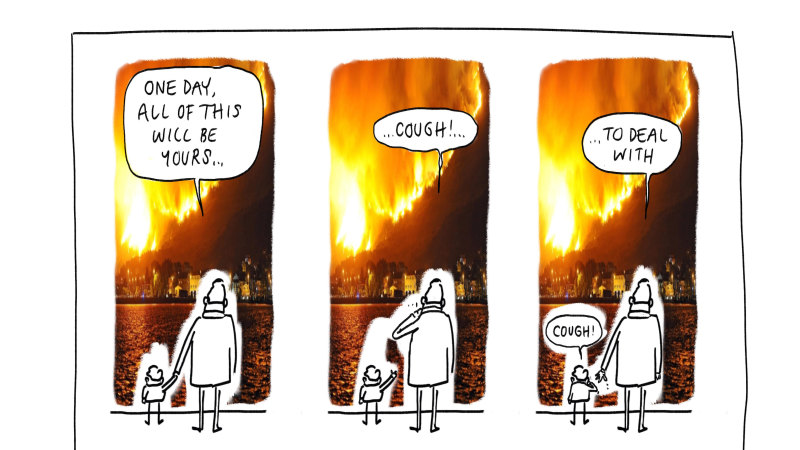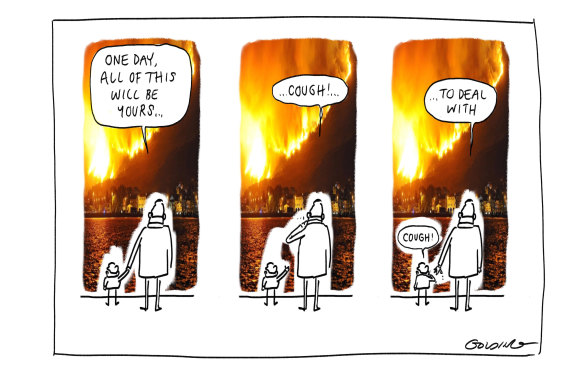The pros and cons of cars v public transport

Save articles for later
Add articles to your saved list and come back to them any time.
Hot deal.Credit: Matt Golding
To submit a letter to The Age, email [email protected]. Please include your home address and telephone number. No attachments, please include your letter in the body of the email. See here for our rules and tips on getting your letter published.
Quick to railroad
North East Link dutifully ticked all the good-process boxes, including with Infrastructure Victoria. But that was in 2016, when its cost was forecast to be between $6 billion and $8 billion. When a project costs four times as much to build as before, it doesn’t magically mean benefits have also increased fourfold. We’ve also had a pandemic that has challenged a lot of modelling assumptions.
New roads have virtually never achieved their forecast time savings. Usually traffic just gets worse, especially on the existing roads that connect to the new one. Allowing people to sit in six lanes of stop-start traffic instead of three isn’t the same as providing productive infrastructure.
North East Link runs for 10 kilometres inclusive of Eastern Freeway widening. Yet it’s now costing 70 per cent what the Parliamentary Budget Office estimated for SRL East, which provides 26 kilometres of rail to short-circuit congested roads. We shouldn’t rush to browbeat big rail projects while big roads get a free pass.
Tony Morton, president, Public Transport Users Association, Melbourne
Travel costs
Norman Day (Comment, 14/12) correctly gives a tick to the old low-rise terraces and their modern equivalents, as providing the best combination of living accommodation, connection to parks, and access to CBDs. Unfortunately, we didn’t manage to make a Paris of our Melbourne, except for those living close to the centre. The rest of us bought (and are buying) houses on large, cheap land lots ever further away; and now we spend our time in traffic jams, rather than at work or play.
Columnist Alan Kohler’s solution is high-speed rail from country centres to the CBD, which still leaves us capital-city dwellers drumming our hands on the steering wheel. Former premier Daniel Andrews’ proposal of rail loops round the city to mini-CBDs at places like Ringwood may provide some alleviation of the problem, but will hardly be a solution; rail journeys will scarcely be high-speed.
Peter Deerson,
Mornington
How to be liveable
Norman Day is right to be concerned about inserting ″pattern″ developments into our urban fabric as a way forward.
Development should not be a one-dimensional approach that makes every place the same or pushes single issue agendas such as social housing regardless.
It’s not desirable for building heights, determined through careful assessment of context, to be then overridden by governments pushing for extra levels of social housing.
If we want connected, vibrant, inclusive communities, that are sustainable into the future, then development needs to respond to all the factors that make places liveable.
Graeme Kelk, Carlton North
The real message
The outrage over the slogans on Usman Khawaja’s shoes, and highlighted by Greg Baum (Comment, 14/12) is both hard to understand and disconcerting. Do those expressing outrage not believe ″all lives are equal”, or that ″freedom is a human right”? In my view these are not political statements but fundamental values that, living in a liberal democracy, we should all share.
Today all professional sportsmen have their clothing covered with logos and messages from sponsors – for commercial gain. Many would find this more offensive than Khawaja’s expression of his humanity but it does not provoke “outrage”. Politicising Khawaja’s action distracts from the underlying message – we all want to see an end to appalling destruction and loss of life in Gaza.
Bob Malseed, Hawthorn
How to make enemies
I was angered, as were many of my friends, at the axing of The Drum. Over the years many of the panelists were women who headed organisations that deal with, for example, mental health, homelessness, imprisoned First Nations children, child sexual abuse, violence against women and refugees. These women and their expertise will vanish from our screens.
Panelists spoke passionately and argued respectfully on the arts, education, science, climate change and medicine and what we heard was important, informative and sometimes very entertaining, unlike the lies and misinformation coming from the mouths of shock jocks or the hysteria from social media.
The Drum beat all other current affairs programs and cancelling it seems like another example of the dumbing down of the ABC. Commentator Rick Morton said that the ABC had made a powerful enemy of their audience.
He was dead right, and one of them is me.
Val Kent,
Mornington
Not a hollow Drum
Such a disappointment that the ABC has axed The Drum. It was a way in for viewers who normally may not have watched current affairs, because, I think, of its relevance to a diverse audience. Watching The Drum felt like watching ″real″ people, not necessarily media personalities.
I was amazed sometimes how articulate people from diverse walks of life came across, with visible empathy and encouragement from the show’s experienced presenters.
Jeltje Fanoy,
Clifton Hill
And in its place . . .?
Why ever take the best discussion program off air when it was such a vital forum for learning about public affairs. It was so much more constructive and interesting than others which seem to be set up to just have conflicting views sparring off each other.
We have no other way of meeting the huge variety of people who know their stuff and who we don’t see on other panels (with a few exceptions).
If we don’t have The Drum, what will we be offered instead?
Cate Lewis,
Clifton Hill
Murders most scowl
It seems to me that the ABC has put iView on rotation for summer with nothing new or probing until February. However, I do find it challenging to remember who “dunnit” in the ancient episodes of Vera or Midsomer Murders.
Davis Baylis, Drouin East
Most Viewed in Politics
From our partners
Source: Read Full Article
